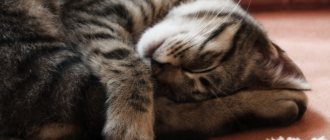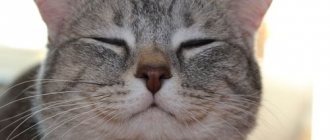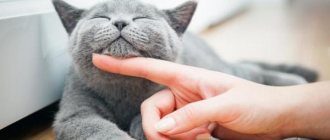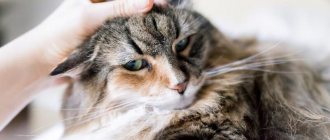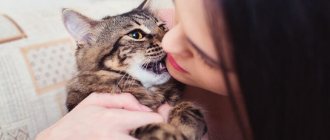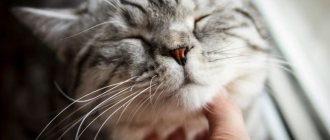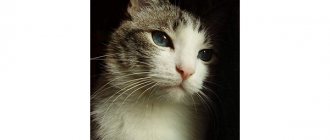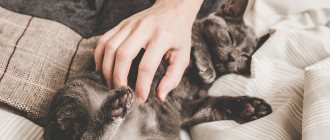The science behind a cat's purring
Just like humans, cats have many ways to signal their presence.
These include sounds and body language. Sounds may include purring, screaming, meowing, hissing, and chirping. Purring is distinguished by the fact that it is present throughout the entire respiratory cycle - both during inhalation and exhalation. The facts behind how this is possible are still shrouded in mystery, but several theories have been floated. Here they are:
Theory #1: Vibrating vocal cords
One theory suggests that the source of purring is the muscles of the larynx, whose job is to open and close the space between the vocal cords (the glottis). The muscles receive a repetitive signal from neurons in the cat's brain, causing the muscles to vibrate between 25 and 150 times per second.
One theory suggests that the source of purring is the muscles of the larynx
Rapid expansion and contraction of the glottis causes detachment of the vocal cords. The air exchanged by the respiratory system during inhalation and exhalation vibrates, resulting in purring. This is the leading theory in explaining the phenomenon. The theory is supported by the fact that cats with laryngeal paralysis cannot purr.
Theory #2: Soft palate
Another theory suggests that purring originates in the back of the throat. This region contains the elongated soft palate, which contains skeletal muscle fibers. This theory states that cats can voluntarily vibrate their soft palates to produce purring sounds.
Theory #3: Boiling Blood
This theory suggests that the purring is the sound of boiling blood. The vibrating sound is the result of increased blood flow in the main artery (inferior vena cava). This artery has a narrowing near the cat's diaphragm. The movement of blood through this narrowing results in a rhythmic noise that is amplified by the diaphragm.
Perhaps purring is the sound of boiling blood
This sound travels through the cat's trachea and cranial cavity, resulting in purring. The hair on a cheetah's chest vibrates when it purrs, which indirectly supports this theory. However, when it comes to domestic cats, their chest hair remains dormant when they purr.
Theory #4: Hyoid bone
The hyoid apparatus is a series of small bones that support the larynx and hold the tongue in place. This theory suggests that purring occurs when the hyoid apparatus vibrates.
Theory #5: False vocal cords
This theory views purring as vibrations produced by the movement of air over the false vocal folds. These mucous membranes are located in the vocal box behind the true vocal cords.
ICP: “Purring Disease”
As the name suggests, feline infectious peritonitis (FIP) is a viral disease that causes inflammation of the stomach lining. The disease occurs when a cat's immune system is unable to fight coronavirus infection.
The name "purring disease" comes from the excessive purring behavior of infected cats. The disease mainly affects young cats who are not yet one year old, as well as old cats.
Feline infectious peritonitis causes excessive purring
The intense form of ICP causes severe damage to blood vessels. They become damaged and leak fluid into the abdominal cavity. This is called "wet" ICP. The cat's belly becomes bloated due to fluid accumulation. An infected cat will also have difficulty breathing due to fluid accumulation in the lungs.
“Dry” ICP is the most persistent form of this disease. It has no external symptoms or obvious signs. An infected cat loses its appetite, its fur becomes dull, and its eyelids turn yellow (a manifestation of jaundice).
An effective form of treatment for ICP has not yet been found.
Regardless, it is important to contact your veterinarian if your pet exhibits any of the above symptoms. Seeing a specialist can save your pet's life if symptoms are a sign of another disease
Cat purring is an amazing phenomenon. In addition to helping the cat relax, it has other functions including communication, bonding between a mother and her kittens, and healing.
Your pet's purring can benefit you. It improves overall health, reduces stress and blood pressure, improves breathing, speeds up the healing of fractures, and relaxes muscles.
While scientists have not yet reached a consensus on exactly how cats purr, the theory that they make the sound through rhythmic movements of the vocal cords after receiving repeated signals from nerve tissue in the brain seems to make more sense than several others that have no serious justification.
Although it is completely normal for cats to purr, not all of them have the ability to purr. Cats that roar cannot purr and vice versa. As a rule, big kitties roar, while small domestic ones purr. Some big cats, such as lynxes and cheetahs, roar, but the snow leopard cannot purr or roar.
Purring too often or for too long may be a sign of a health problem called ICP, more commonly known as “purring disease.” ICP is accompanied by other symptoms. A visit to the veterinarian if your cat shows signs of illness can save your pet's life.
Why does he purr when you pet a cat?
Don't be surprised if you pet your cat for a long time and he will start purring. This is connected precisely with receiving positive emotions. The animal likes such stroking, it calms it down. Accordingly, the cat makes a characteristic sound. Sometimes pets can come to their owners, lie down next to them and purr for no apparent reason, even if you don’t pet them. This is connected precisely with the desire to improve health.
Often cats lie down near the area that is sore. Perhaps these are chronic diseases. It is at such places that cats lie down, lean against them and purr. In this way they try to cure their owner. A cat may purr for the simple reason that it is hungry or wants to go for a walk. Accordingly, in this case, the nature of the purring will be different.
Petting the cat
4–5 months: adolescence
The nutrition of a growing pet should consist of kitten food, which contains substances necessary for normal development. It is recommended to feed animals about 5 times a day. By the end of the fifth month, a three-times-a-day diet is established.
The appearance of the kitten changes, its body increases in size, its muzzle and tail lengthen, and its paws stretch. The pet can already be mistaken for an adult cat, he plays less with toys, sleeps more and strives to communicate with people. At 5 months, the kitten’s baby teeth begin to fall out and permanent teeth begin to grow.
Why do kittens purr?
British scientists have found that cats can purr starting from the age of two days. In this way they signal to their mother that they are hungry or afraid of something. This is a unique way of communication between kittens and an adult cat. We can say that they speak such a unique language.
Thus, the cat often leaves her kittens to eat. If she is in the wild, then approaching her nest, she begins to purr, thereby informing her kittens that there is no need to squeak, she is nearby and is already approaching the house. At the same time, kittens may purr in response. This happens especially often if the cat licks them and cares for them. This is a kind of gratitude, the kittens seem to tell her that they are warm, good and very happy. Zoologists believe that such purring of small kittens stimulates lactation in a cat and provokes it to better care for its offspring.
Cat
As you can see, cats purr for a variety of reasons. If, during prolonged petting, your pet does not purr, but ignores you, you should think about the psychological comfort of the animal. Perhaps the cat is dissatisfied with something or feels negative emotions on your part.
Childhood element
The purring of a cat is an element of its childish behavior. Week-old kittens begin to purr when their mother feeds them. Purring unites the cat family. The kitten purrs with pleasure as he suckles his mother in the company of his siblings.
A caring mother responds with a gentle purr. She reports that everything is fine, mom is nearby, she will always protect and feed her fluffies. Kittens remember these moments of complete mutual understanding and well-being for the rest of their lives. They will seek this feeling in a stressful situation in order to overcome stress.
Very soon, purring becomes a means of communication between cats and kittens. Then the older cat begins to communicate with the person using the same skill. A domestic cat retains this skill throughout its life and often practices it. We cultivate this infantile behavior in every possible way, caressing our pet without any reason or reason.
Purring expresses the absence of fear and harmony with the owner. This may be a demand for attention, a sign that it is time to feed a hungry four-legged creature.
A feral cat loses his purring skill because he lives alone. It happens that pets almost never purr. My friend cat Vanilla has a stern character, despite her sweet name. She purrs only when she receives her favorite pate. But the owner loves her for who she is.
Educational facts
- Some people explain the purring mechanism with other versions. For example, such a sound creates a kind of air flow in the lungs and blood circulating in the veins in a special way, which is subsequently converted into sounds in the head.
- It has been found that certain breeds of cats purr more often than others, while others purr less often. For example, Siamese and Thai breeds are considered to purr most often, and breeds such as Devon Rex and Ragdoll are considered the least likely.
- If your cat used to purr often, but now for some reason has stopped, then you should think about whether he is comfortable and cozy. Perhaps the cat is showing his resentment or dissatisfaction with something.
- Many people, thanks to a cat's purr, seem to calm down and relax. There is an assumption that cats are capable of treating people with their vibrations, for example, from hypertension.
- Even cats that are deaf from birth can purr.
- It is worth noting an interesting fact that the vibration of the purring sound spreads throughout the cat’s body, so during this process it is impossible to listen to the heartbeat and breathing. In order for the purring to stop, they usually turn on the water, since the sound is very alarming to the cat, and it becomes distracted.
Why do cats love to rub against people and objects?
Contents hide
Why do cats love to rub against people and objects?
We address this article mainly to novice cat lovers, because these wonderful animals often demonstrate, to put it mildly, somewhat strange behavior to their owners. But this behavior is by no means a quirk of your cat; it usually means something! To better know and understand your pet, it is advisable to understand and study everything. Some of the strange behavior of cats is often interpreted erroneously: for example, when a cat begins to rub against its owner's legs, it is believed that it is simply caressing. No: the cunning creature pursues completely different goals!
The importance of smell. Our furry friends have a sense of smell 200 times more sensitive than you and I
So you can put into circulation the stable expression “cat’s scent”, and it will be fair! In addition, cats both transmit and sense pheromones. They are spread by special glands located in the area of the paw pads, forehead, cheeks, chin, lips and tail area. Pheromones are unique for each animal, its unique calling card. The cat will walk by, rub various parts of its body against people or some objects, and mark them - that is, leave its unique scent. Other cats quickly recognize (feel) them and realize: this place is already occupied by another cat who was here before me.
Expressing good feelings. Cat lovers know well that their pets, in moments of pleasant mood, love to rub their faces or even lightly butt their owners with them. You understood everything correctly: and at this moment the cat releases pheromones. But “facial” pheromones have a special effect - the animal calms down, demonstrates affection and friendliness. Sometimes a cat rubs its muzzle against things and objects - this is normal. You and I pet cats, play cuddle games, animals rub against us during petting. It is at this moment that there is an intense exchange of odors. Cats thereby show that we humans completely belong to them and are in their power. And try to argue something!
Means of communication. A cat can send unambiguous hints to its owners - it’s time, dear man, to have some food! In this case, the animal will write out complex steps around the legs of its owners, then, as if by chance, walk to its bowls, demonstrating where to go and what operations to perform. Then he returns to his feet - well, let's go quickly, sloth!
Some cats accompany their unlucky owners to the trays, suggesting that they have long been in need of cleaning and cleaning. Sometimes cats literally launch a frontal attack: that is, they move their foreheads towards their owner, lightly butt them, and then expose their necks. What to do? Of course, scratch and stroke your pet in the most sensitive places!
There are several cats in the house
If you have several cats in your house, then pay attention - they butt and rub against each other in the same way. The essence of the process is the same: animals exchange odors
This is how they feel safe and comfortable - they now perceive the unique smells of their “comrades” exclusively as friendly, “group” ones. Look: as soon as one cat leaves its scent somewhere, another will immediately come up to this place and rub its muzzle.
And finally, the last fact: the cat, when searching for a “gentleman” and attracting him for mating, also uses the appropriate pheromones. Sometimes there are so many contenders for the heart of a furry beauty!
Photo: viralife.ru, lol24.ee (from open sources).
Anatomical mechanism that produces purring sounds
In general, purring is a long, rhythmic vibrating sound that only cats can make.
For a long time, scientists did not know exactly how purring occurs, since there is no separate special organ responsible for these sounds.
The latest and most accurate version is that the sound is produced by the hyoid bones. Electrical impulses in the brain travel to the muscles near the vocal cords, and in turn cause the muscles also nearby to vibrate.
Scientists have found that the average frequency of purring in domestic cats is 20–30 hertz. In this case, the frequency of, for example, cheetahs is 18 hertz.
It is interesting that a person cannot learn to purr, no matter how much he wants to, since people do not have the appropriate structure and do not have hyoid bones. So all that a person can make are certain sounds.
Many representatives of wild cats can also only growl, but not meow. This is explained by the fact that their hyoid bones are overgrown with cartilage, so they can no longer act on the muscles next to the vocal cords.
Caring for the health of others
According to research, purring has beneficial effects on cats and people. It releases endorphins - happiness hormones - in the cat's body. This allows you to alleviate pain and recover from a serious illness.
Cat singing has a positive effect on people:
- Reduces blood pressure.
- Slows down the accelerated heart rate.
- Regulates and calms breathing.
A sensitive animal will always notice the owner’s fatigue and discomfort and begin his music therapy on time.
Purring vibrations promote healing of bones after a fracture and improve the condition of muscles and ligaments. The frequency of 26 hertz helps restore all types of tissue.
Purring is considered an element of zootherapy, which is becoming increasingly widespread, because contact with animals has a beneficial effect on children and the elderly:
- Develops psychomotor skills.
- Strengthens memory.
- Improves orientation in time and space.
- Positively affects the emotional state.
- Improves relationships in the family and team.
How to understand by sound what a cat wants
The talkativeness of an animal depends on both the breed and individual characteristics. Oriental and Siamese cats are considered the most sociable among breeders. Representatives of the popular British breed also love to “talk.”
Sociability largely depends on the animal's temperament. In the same breed there are both silent people and lovers of small talk.
The dream of any owner of a furry animal is to be able to understand what a cat’s purring means. A cat's purring can be considered a similarity to such a “dictionary”. Scientists believe that the human ear is able to distinguish 16 vocal signals that a cat makes. By about three months of age, the kitten fully masters its vocabulary.
To understand a cat's language, you should listen carefully to the intonation. As a rule, a soothing purr in a calm environment indicates that the pet is happy, well-fed and in a favorable mood. This is how the animal expresses sympathy and gratitude to the owner. Uterine rumbling and even hissing can indicate fear or anger.
If a cat greets its owner with a short “meow” on a high note and then begins to purr, then in cat language this means a normal greeting. If the animal experiences joy when meeting its owner, several such “meows” will follow.
Rumbling with a demanding, prolonged meow most likely means a request. Owners often encounter such sounds when the pet is hungry or begs for some kind of tasty treat. With approximately this intonation, a cat can complain about something.
Purring in this case can also indicate health problems or fear.
Not only sounds, but also body movements, especially the tail, eye expression, and even twitching of the tips of the ears and whiskers are of great importance in mastering the cat language. We recommend reading about how cats see. You will learn about the peculiarities of cat vision, how they see in the dark, the ability to look into the distance, and is it true that cats are color blind?
Vocal lessons for mole rats
Kittens learn to purr at a very early age. While eating, the still blind babies purr to their mother: “It’s delicious for us, it’s warm. Everything is fine". When mom licks the kittens, they purr to her about how warm and pleasant they are. When kittens begin to purr, the cat always responds with a gentle purr: “I’m here, you’re safe, I’ll take care of you.” Some zoologists believe that the purring of kittens stimulates lactation and encourages the mother to care for her offspring more carefully.
But how does a kitten know how to learn to purr like a mother cat? Scientists have come to the conclusion that babies simply imitate a cat, adopting this science on an intuitive level.
How else? After all, it is vital that kittens can communicate with their mother using quiet sounds without giving away their presence. Sound therapy at competitive prices!
Attention, promotion! If you know how to make a cat purr, you can use the wonderful effect of a mustachioed rattle for a very reasonable price. Scientists have long noticed that the purring of a cat has a beneficial effect on the emotional state of even those people who are indifferent to these animals.
Perhaps it's all about the frequency of the sound. Or in the nature of measured vibrations. Or maybe in the resulting electromagnetic field? Be that as it may, the sound, designed to calm babies and the cat itself, really restores peace of mind. If your cat stops purring, simply pay for another hour of therapy. The following are accepted as payment: sincere affection, gentle ear scratching, chicken fillet and yesterday's kefir (we secretly inform you that after consuming fresh kefir, a long biopause is possible).
Signs
There are many popular signs and superstitions about cats and their behavior towards humans. Here are a few that involve skin-to-skin contact:
- If a cat rubs against a person, and he shows reciprocity, in this way the animal transmits positive energy, and, on the contrary, takes away negative energy;
- If a person pushes away an animal trying to rub against his legs, he drives away luck, strength, luck;
- When a pregnant cat rubs against your legs, it promises a person quick luck, financial gains, and a big win;
- If a strange cat comes into the house and tries to rub itself against the residents, walls, floor, this indicates that evil spirits live here;
- When a cat tries to rub against a person’s face and warily sniffs the air exhaled by him, this indicates the onset of the disease;
- If a dirty, thin, mangy cat wants to rub against a person, it means he or someone close to him will soon get sick.
Felinologists note that a cat rubs against its owner’s legs to leave its own unique scent, show affection, or soothe. It is recommended to encourage the actions of a pet, since an animal that does not receive reciprocal affection will harbor a grudge. Researchers studying the therapeutic effects of pet therapy speak positively about the effect of purring cats and kittens on the human central nervous system and the functioning of the gastrointestinal tract.
Anatomy
Everyone knows how and why cats meow. But why do they purr? How can a pet make such sounds without opening its mouth? Why do cats purr when you pet them? Experts say that this is due to the physiological characteristics of the cat’s body.
First version
The cat's brain continuously sends signals to the muscles of the vocal cords. Under the influence of electrical impulses, muscle contraction occurs, which causes vibration. If the animal’s mouth is slightly open at this time, it meows, and if it is closed, it emits a purr. There are unusually shaped bones under a cat's tongue. When the vocal cords vibrate, the sound resonates in this apparatus, and we hear a purr. Because of this feature, the hyoid bones are called false vocal cords.
Second version
The next possible cause of purring: it is caused by the movement of air in the lungs. However, this version does not yet have a scientific basis. It has only been proven that an animal can make such a sound both when it inhales and when it exhales. How loud and intense the purring is does not depend in any way on the direction of the air currents.
Third version
Cats can cause the blood that circulates in the vessels of the throat and chest to vibrate. These vibrations resonate in the intracranial sinuses, after which they become sound waves.
Only pets, as well as their small relatives living in the wild, can make such a sound. The thin bones of large predators are covered with cartilage, which prevents them from purring.
Main reasons
There are many versions that explain the reason for the rumbling of domestic cats. The following options are recognized as the main ones.
- Gratitude. Cats purr when they show gratitude to a person for treats, affection, touches and warmth. In this regard, a barely audible purr is a sign of a contented cat.
- Relaxed state. If the pet is in a calm state, then it begins to purr. The same situation can be observed when kittens, sitting in a calm and peaceful state, suck their mother’s milk. Since it is not possible to meow and eat food at the same time, they purr barely audibly.
- Showing your emotions. Most people believe that when a cat purrs, it means the cat is singing its song. With the help of different intonation, pronunciation of sounds and vibrations, pets demonstrate their mood at the current moment. This is comparable to people who, in a relaxed state, begin to hum certain tunes to themselves.
- Conversations between kittens and mother cat. With the help of rumbling, little children tell their mother that everything is fine with them, they are full and satisfied. This indicator is important among wild felines, since parents can often leave their children alone when going hunting.
- When self-medicating. If a cat is sick or stressed, it begins to purr to find peace and restore the state of its body. With the help of vibrations produced by cats, blood circulation processes are improved, which improve metabolism. Purring helps cats warm up or calm down. At such moments, it is better not to touch your pet and let him recover on his own.
- Before bedtime. When an animal is about to sleep, it may purr quietly. Thanks to uniform vibration, he is able to find calm and tune in to sleep. Scientists have conducted studies in which it was found that when rumbling, it is impossible to hear breathing and heart rate, since the vibrations are strong in their manifestation. Due to this feature, pets get a good night's sleep.
- Demonstration of hunting instinct. The rumbling can be heard at the moment when the animal is watching a bird through a window or watching a fluttering leaf in nature. With the help of such manifestations, the animal shows its interest in objects.
- Demonstration of self-defense. A cat may purr loudly if it senses danger. It is better not to touch an animal that is in this state, as you may encounter the fact that the pet may bite or attack.
- Feeling of fear. With severe fear, manifestations of an exciting rumbling may be observed. This suggests that it is better not to touch the animal or, on the contrary, it feels defenseless and needs protection.
- The goal is to get something. If a pet wants to receive a treat from its owner, then it begins to purr. In most cases, this technique works flawlessly, and the cat gets what he wants.
- Disease. Rumbling may indicate illness. In this case, the animal will produce loud and restless sounds. If this behavior occurs, you should contact your veterinarian.
Cats can purr for any reason. However, only very attentive people who care about their little friends are able to understand the true reason for this behavior, and they carefully monitor the well-being and mood of their pet.
2–3 month old baby: development, first vaccinations
By 7–8 weeks, the color of the iris becomes constant. Animals that have been trained to use a litter tray begin to look for it on their own, so they rarely make puddles in the wrong place. This is the right time to look for new owners.
The weight of a two-month-old kitten, depending on the breed, ranges from 400 to 900 g. This is the period when mother’s milk ceases to be an integral part of the daily diet of older babies. They occasionally cuddle with their mother to feast on her and feel her warmth and care, but the animals feed on their own. For a two-month-old pet, feeding five times a day is optimal. Water must always be available.
At 2 months, pets begin to purr if they enjoy petting. Kittens become extremely active, they get into the most inaccessible places, they can run out the door and end up on the street. The owner should be especially careful when leaving the house.
At 2.5 months, babies receive their first vaccinations. However, if there is a risk of early infection with dangerous infections, then vaccination is carried out earlier than 8 weeks.
A three-month-old kitten has a well-developed musculoskeletal system, he knows where his bowl and tray are, and willingly comes running when his name is called. The body weight of a three-month-old cat is about 1.3 kg.
Why do cats purr?
Not long ago, British scientists determined that cats can purr in order to improve their health or cure their owner, possibly another pet. Sound therapy has been known for a long time. It’s not for nothing that sick children are played classical music. The actual process is almost the same.
British scientists in a study found that the sound of a cat purring is observed in the range of 20-150 hertz. Moreover, from 20 to 140 - this purring is therapeutic. It has been found that such purring heals bone tissue, promotes restoration of the body, and also cures diseases of the heart and blood vessels.
White cat
The cat's stomach is rumbling and vomiting
In a situation where a cat’s stomach is rumbling and vomiting, you should be wary. Vomiting is one of the symptoms of gastritis or other diseases of the stomach, problems with bile secretion or pancreas. Such diseases most often have many other signs in addition to rumbling in the stomach and vomiting:
- loss of appetite;
- frequent constipation or diarrhea;
- increased salivation;
- exhaustion;
- hair loss;
- depressed state;
- frequent screams during the day and at night.
Typically, such serious diseases can be congenital or develop during prolonged malnutrition and the owners ignoring the corresponding symptoms. Gradually, the animal’s condition worsens more and more, and it may stop eating and drinking for a long time, and spends most of its time sleeping. Simple measures will no longer help here, and it is necessary to show the cat to a veterinarian as soon as possible. At the clinic, the animal will be prescribed anti-inflammatory drugs and medications that improve digestion. In addition, the doctor will tell you in detail how and what is best to feed your cat in order to avoid unpleasant rumbling in your pet’s stomach.
170
Category: Nature
Why do cats purr next to humans?
Cat owners will always confirm that there is nothing more relaxing than sitting with their pet on a chair to the ringing accompaniment of purring.
We are accustomed to the fact that the only reason for such sounds is happiness and are often surprised when an animal makes such sounds supposedly for no reason.
However, cats are full of mysteries, which are not always easy to solve. In fact, these animals have many reasons for purring.
The cat conveys to her kittens that she is here to calm and protect the children. The babies respond by purring to show that they are happy and well-fed.
Photo: a cat communicates with kittens using purring
Also, with the help of a kind of “cipher”, pets can establish relationships between each other, invite them to various games, greet each other, and in case of a dispute, show reconciliation.
With the help of rhythmic chattering, animals express many emotions and feelings:
- joy and peace;
- feeling of pain and weakness;
- anxiety and fear;
- stress;
- needing something and showing gratitude;
- love and care;
- interest in something.
Photo: Merlin and Smokey - the loudest purrs on the planet
Did you know that in 2013, an English cat named Merlin from Devon became famous as the loudest cat. His purr is about 100 decibels, and the average for ordinary cats is 25!
Merlin's chirping drowns out the noise of the hairdryer and dishwasher. Before this, the Englishwoman Smokey was considered the loudest cat, losing only a few decibels to her fellow countryman. Many people who personally met her compared her purring to the noise of a landing Boeing.
When you pet them
Cats love communication and affection, so it is extremely important to give them attention. Particularly gentle pets literally demand to be petted or carried. In such sensual moments, cats begin to purr loudly, showing how happy they are and how much they love you.
In such sensual moments, cats begin to purr loudly, showing how happy they are and how much they love you.
Photo: cats purr when they are happy
Scientists explain purring during petting by the fact that among the ordinary hairs in pets’ fur there are small whiskers (similar to antennae, only much thinner and shorter), which, when caressed, bend slightly and send pleasant signals to the animal’s brain.
Crushing with claws
You've probably noticed that purring pets have a habit of kneading their paws in the air, the blanket, or their owner. Many people find this behavior funny and cute.
Photo: stamping paws and purring - a pleasant childhood memory
Usually, kneading with claws is accompanied by a loud rumbling. The fact is that when stroking, the pet remembers its mother, who also cared for and protected it.
The instinct to move their paws has been preserved since childhood: kittens showed with similar movements that they want to eat. Naturally, pleasant childhood memories evoke only happiness.
Falls on the owners
Cats can show the utmost love and care by periodically laying down on a person. Various reasons are also attributed to such behavior, even quite dubious ones, for example, the desire to control and dominate the owner.
In fact, cats feel safe when they are with part of their family. And many pets simply enjoy spending time relaxing with their loved one.
Photo: lying on a person, cats show their love and care
Their warm fur warms them, and the purring that accompanies sleep with the help of vibrations normalizes blood pressure, relieves nervous tension and heals bones and muscles.
6–7 months: puberty
At 6–7 months, cats finish changing their teeth. The permanent incisors grow first, then the canines. The process of puberty is actively underway. Pets may become restless, some begin to mark their territory. During this period, hormonal levels change and animals may show aggression. If a pet tries to bite or scratch its owner, such attempts must be stopped.
The weight of a cat at 6–7 months reaches 2.4–.6 kg. Externally, the animals look like adult cats. They have developed hunting instincts, their movements become smooth and graceful. In the autumn-winter period, young cats undergo their first molt. Animals should be brushed regularly to prevent hairballs from forming in the stomach.
Purring mechanism - how do cats purr?
For a very long time, many zoological scientists struggled with the mystery of the organ responsible for a cat’s purring.
The rumbling is associated not so much with the internal organs of the cat, but with its brain activity.
For many years, research on animals led to nothing, until one of the scientists put forward a hypothesis according to which rumbling is associated not so much with the internal organs of a cat, but with its brain activity. And indeed, the animal’s brain sends certain impulses to the body, as a result of which this enchanting sound is heard.
Where does the sound come from?
The cat's hyoid bones interact with the vocal cords to produce a purr.
But the question still remained open, which organs are responsible for the physical transmission of sound in space.
The answer was found just a few decades ago - the thin hyoid bones of a cat interact with the contracting vocal cords as a result of a signal received from the brain. It is this interaction that creates such amazing sounds that the animal can use at its discretion.
